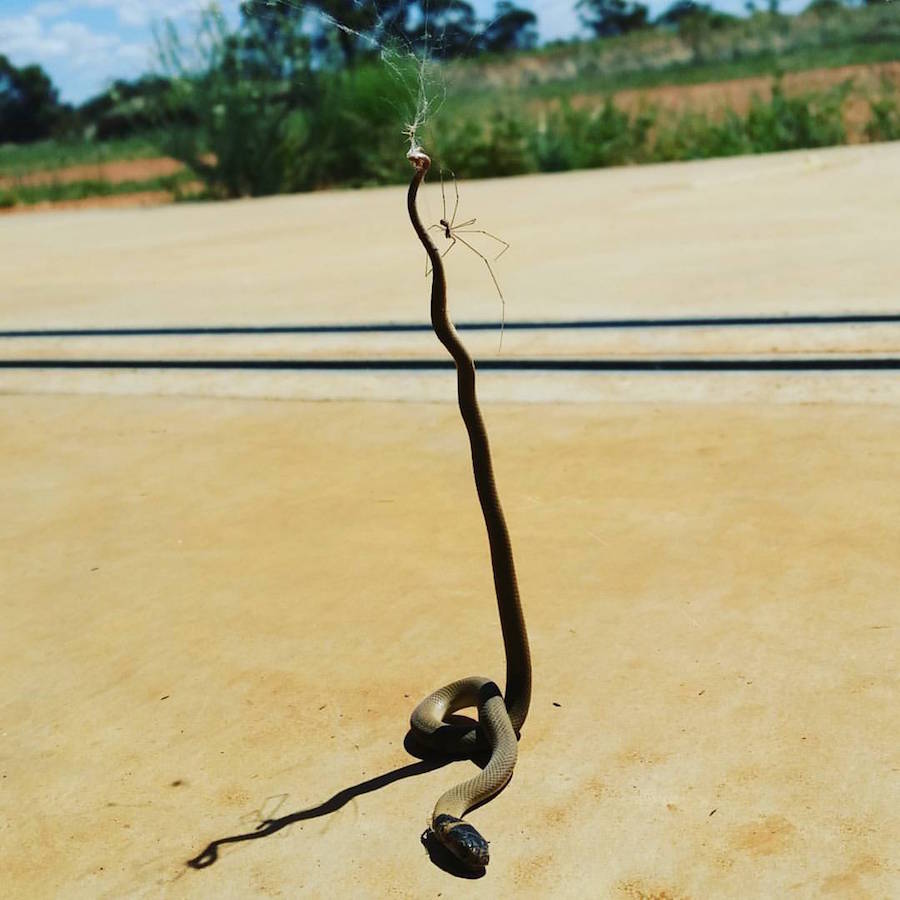Reptile Dysfunction: Snake Loses Wild Battle Against Spider (Photo)

A farmer in Australia who lives "in the middle of nowhere" got a creepy treat over the weekend when he came upon a dead snake dangling like a titanic trophy from the web of a daddy longlegs.
Turns out, the spindly spider may have given the snake a run for its money.
"When I walked out to the shed on Sunday and saw this brown snake strung up by a daddy longlegs in its web, I couldn't believe it," said Patrick Lees, who runs a farm of cereal crops in Weethalle, New South Wales. "So I took some photos and shared them on a Facebook page I've started called 'the Aussie farmer,'" said Lees, who captured the snake-spider encounter on video.
"I'd never seen anything like it before," Lees told Live Science. "People have this idea that everything in the bush is trying to kill you, but this took it to the next level. I just thought it was a classic Australia moment and had to share it." [See Photos of Spiders Ensnaring Bats in their Webs]
This daddy longlegs was likely a type of cellar spider in the Pholcidae family; the mild venom of such spiders could've been potent enough to kill the snake, one expert said. (The term "daddy longlegs" is also used to refer to harvestmen, which are not spiders, don't have venom and don't spin webs.)
"I have never seen a pholcid spider catch a snake or other vertebrate in its web, but I have seen lizards caught in the webs of other spiders," such as widow spiders, said Lorenzo Prendini, curator of Arachnida and Myriapoda at the American Museum of Natural History in New York City.
Though mild, "their venom may be powerful enough to subdue a small vertebrate like this snake," Prendini told Live Science in an email.
Get the world’s most fascinating discoveries delivered straight to your inbox.
Another spider expert, James Starrett, has also heard of black widow spiders, but not daddy longlegs, killing vertebrates with their venom.
"I guess it is possible that the spider was able to injure the snake with a bite, but it could also be that the snake just got tangled in the web and wore itself out trying to get free," Starrett, of San Diego State University, told Live Science. "I can't really say with out witnessing it."
What's in store for the dangling snake? "The snake was dead when I found it, but I left it there because I couldn't take down his trophy," Lees said.
The spider may have plans beyond keeping the slithery corpse for show: "The spider will slowly feed on it over a period of days. This will involve a process of external digestion: The spider will release digestive enzymes onto the snake flesh, which will effectively liquefy it," Prendini said. "The spider will then suck up the digested juices, ultimately leaving a dry husk of undigested skin and bone. It is highly unlikely the spider would digest and eat an entire snake of this size, however."
Follow us @livescience, Facebook & Google+. Original article on Live Science.
Jeanna Bryner is managing editor of Scientific American. Previously she was editor in chief of Live Science and, prior to that, an editor at Scholastic's Science World magazine. Bryner has an English degree from Salisbury University, a master's degree in biogeochemistry and environmental sciences from the University of Maryland and a graduate science journalism degree from New York University. She has worked as a biologist in Florida, where she monitored wetlands and did field surveys for endangered species, including the gorgeous Florida Scrub Jay. She also received an ocean sciences journalism fellowship from the Woods Hole Oceanographic Institution. She is a firm believer that science is for everyone and that just about everything can be viewed through the lens of science.


